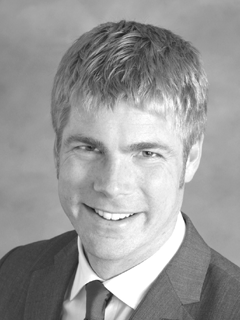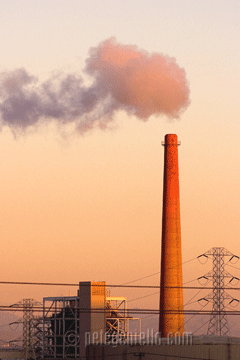Questionable Credits
Air Date: Week of May 30, 2008

MIchael Wara is a research fellow and lecturer at Stanford Law School. (Courtesy of Stanford University)
A Stanford team of researchers finds many credit-for-cleanup projects in developing countries under the Kyoto agreement would have happened without the credits, and that means no net improvement for the Earth's atmosphere.
Transcript
GELLERMAN: Now notice what he says about carbon credits: they’re the financial fuel that drives the Persian Gulf eco-paradise, and they’re critical to most plans to offset global green house gases. Okay, your eyes are glazing over, but understanding carbon credits is actually pretty simple.
The carbon credit system was created by the Kyoto Protocol. It’s called the CDM, or Clean Development Mechanism. Here’s how it works: an industrialized country or company producing greenhouse gases can offset its pollution and get credit by bankrolling clean carbon projects in developing nations. Michael Wara of Stanford University’s Program in Energy and Sustainable Development investigated the CDM system.
WARA: What the CDM does is to create a way for – or in theory create a way for – developed world governments and firms to invest in cleaner technology than would have occurred otherwise – push the developing world onto a cleaner development path. That's why they call it the Clean Development Mechanism. Now, this is in theory, and there are a lot of details that have to be worked out to make the theory work in practice.
GELLERMAN: Well how does it work in practice?
WARA: Well our study, and I think the work of many others, suggest that there are a lot of areas where it's not working well.
GELLERMAN: Well, let's take a concrete example.
WARA: Okay.
GELLERMAN: Let's say I'm running a brewery in Vietnam.
WARA: Mm hmm.
GELLERMAN: And I'm creating a lot of heat; I'm using charcoal or diesel fuel, and we're producing a lot of greenhouse emissions. Someone from Europe has a factory and wants to pay us money to convert to a cleaner process.
WARA: Sure.

powerplant_portrero.gif
WARA: Right.
GELLERMAN: Win-win.
WARA: Win-win, in theory. Now, here's the question, though. What other incentives did you, the brewery-owner, have to switch fuels, to switch processes to a cleaner process? Very often, it turns out, there are multiple incentives to make that switch.
GELLERMAN: So without the credits I would have made the switch anyhow.
WARA: Possibly. It's a tough decision that has to be made, and ultimately that decision has to get made for credits to be issued. Someone has to say, this wouldn't have happened without the credits, or, it would have. And that's important for a key reason: these credits go to Europe or other countries that have signed and ratified the Kyoto Protocol, and they're used in lieu of emission reductions within those countries. So the reduction happens in Vietnam, but it doesn't happen in Germany. If the reduction in Vietnam would have happened anyway, then you're not getting the reduction in Germany, and you're not getting the reduction in Vietnam.
GELLERMAN: What percentage of the projects do you think are getting credits that shouldn't get credits?
WARA: Between a third and half of the projects are representing behavior that would have happened anyway – that don't, aren't really real reductions.
GELLERMAN: And you looked at, what, 3,000 projects?
WARA: Yeah, roughly.
GELLERMAN: And half of those shouldn't have been funded.
WARA: Well, this is the hard thing. So let's take a different concrete example. What if you're a wind farm in China. China is becoming one of the largest producers of wind energy in the world. Part of the reason for that is the, is the subsidy provided by the CDM. But we think a much bigger part of the reason is the incentives and subsidies provided by the Chinese government, because they're desperate for electricity right now, and they're especially desperate for clean electricity that doesn't make their citizens sick, like coal-fired power does. So how do you tell, for an individual wind farm, whether it would have been built or not?
GELLERMAN: Well, who does the deciding?
WARA: Well, most of the actual evaluation of projects happens – is done by private third parties that act sort of like a credit-rating agency.
GELLERMAN: But now as I understand it, they're paid for by the companies they're certifying.
WARA: That's right, and that's a real problem in the sense that, you know, these –
GELLERMAN: It's a conflict of interest.
WARA: We believe so, yeah. And one of the reforms that we argue for quite strongly is that that conflict of interest needs to be removed, and that it would improve the quality of the certification and the evaluation of these projects, the evaluation of what would have happened anyway?
GELLERMAN: How big an industry is the CDM's?
WARA: Last year the market was worth about 20 billion dollars.
GELLERMAN: Twenty billion?
WARA: Billion, with a B. But I think the more important thing to focus on is the fact that the market's been doubling or tripling in size every year for the past four years.

Michael Wara says the UN's carbon offset program isn't forcing industrialized nations to cut back on pollution as much as intended. (Photo: Pete Geniella/petegeniella.com)
WARA: Yeah, I think there are some very good examples, where there's really no money to be made in the change in behavior other than the carbon credit. So, things like the capture of methane emissions from landfills and from animal feeding operations. These are places where methane, which is an incredibly potent greenhouse gas – it's about 25 times worse than CO2 – is emitted in large quantities, basically from the decay of organic matter. And it's pretty easy to go in and capture all or most of those emissions. But there's no financial incentive to do so. So the CDM has catalyzed a lot of activity around capturing these emissions, and that's had a really positive impact on greenhouse gas emissions.
GELLERMAN: Well, Michael Wara, thank you very much.
WARA: It's been a pleasure.
GELLERMAN: Talking to us about the carbon credit system is Stanford University’s Michael Wara, co-author of a recent paper investigating the CDM – the Clean Development Mechanism.
Links
Living on Earth wants to hear from you!
Living on Earth
62 Calef Highway, Suite 212
Lee, NH 03861
Telephone: 617-287-4121
E-mail: comments@loe.org
Newsletter [Click here]
Donate to Living on Earth!
Living on Earth is an independent media program and relies entirely on contributions from listeners and institutions supporting public service. Please donate now to preserve an independent environmental voice.
NewsletterLiving on Earth offers a weekly delivery of the show's rundown to your mailbox. Sign up for our newsletter today!
 Sailors For The Sea: Be the change you want to sea.
Sailors For The Sea: Be the change you want to sea.
 The Grantham Foundation for the Protection of the Environment: Committed to protecting and improving the health of the global environment.
The Grantham Foundation for the Protection of the Environment: Committed to protecting and improving the health of the global environment.
 Contribute to Living on Earth and receive, as our gift to you, an archival print of one of Mark Seth Lender's extraordinary wildlife photographs. Follow the link to see Mark's current collection of photographs.
Contribute to Living on Earth and receive, as our gift to you, an archival print of one of Mark Seth Lender's extraordinary wildlife photographs. Follow the link to see Mark's current collection of photographs.
 Buy a signed copy of Mark Seth Lender's book Smeagull the Seagull & support Living on Earth
Buy a signed copy of Mark Seth Lender's book Smeagull the Seagull & support Living on Earth

